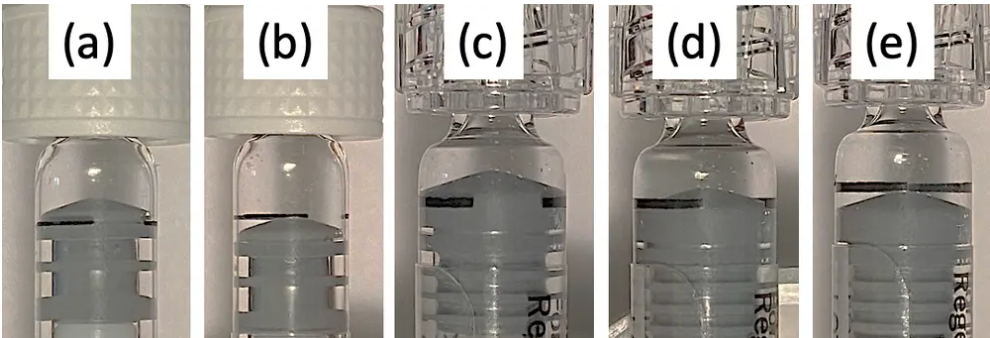Article
Study examines dosing variability with aflibercept pre-filled syringes
Author(s):
Roger A. Goldberg, MD, MBA, notes how small misalignments in the plunger can lead to possible overdosing.
Images of plunger / dose mark alignment strategies. (a) ranibizumab PFS with plunger aligned according to IFU (condition 1) (b) ranibizumab PFS with plunger cone tip aligned to dose mark (condition 2) (c) aflibercept PFS with plunger aligned according to IFU (condition 3) (d) aflibercept PFS with leading plunger rib aligned to top (distal to needle) edge of dose mark (condition 4) (e) aflibercept PFS with plunger cone tip aligned to top (distal from needle) edge of dose mark (condition 5). (Images courtesy of Roger A. Goldberg, MD, MBA)

There is a potential for overdosing of aflibercept (Eylea, Regeneron) as a result of small mis-alignments of the plunger when administering the drug in prefilled syringes, according to Roger A. Goldberg, MD, MBA, in private practice in Walnut Creek, California.
Goldberg presented the information at the American Academy of Ophthalmology 2021 annual meeting in New Orleans.
According to Goldberg, this can lead to a doubling of the volume delivered using these plungers, and this is likely due to the internal diameter of the syringes and the wide dose mark thickness.
This overdosing is probably the culprit in the increasing reports of intraocular pressure (IOP) elevations and transient central retinal artery occlusion since the syringes came into use in August 2019.
The prefilled syringes were designed to store and deliver aflibercept 2.0 mg/0.05 mL. The product is packaged as a 1-mL glass syringe with a domed-plunger tip and a dose mark to facilitate proper volume delivery for intravitreal injection, he described.
Goldberg performed a study of the characteristics and design of the prefilled syringes and tested the delivered dose across a range of potential plunger settings for the aflibercept prefilled syringes.
Using purified water, he assessed 3 potential syringe settings in 15 syringes: 1, plunger base aligned to proximal edge of dose mark (the manufacturer’s instruction for use); 2, plunger base aligned to distal edge of dose mark; and 3, plunger tip aligned to distal edge of dose mark.
“The internal diameter of the aflibercept prefilled syringe is 6.35 mm, leading to a volume delivered of 31.7 uL/mm,” Goldberg said. “Digital caliper measurement of the dose mark revealed a thickness of 0.75 mm, leading to a potential dosing error due to the dose mark thickness of 23.8 uL. Dose-delivery testing showed the respective averages ± standard deviations delivered dose across scenarios 1, 2, and 3: 54.8 ± 5.7 uL 78.9 ± 5.7 uL, and 109.7 ±3.4 uL.”
These differences reached significance (p < 0.05).
“Small plunger misalignments can lead to administration of double the volume of aflibercept delivered using the aflibercept prefilled syringe, which likely account for the increased reports of IOP elevation since its launch," Goldberg said. "Proper adherence to the IFU can minimize dosing errors.”
Newsletter
Don’t miss out—get Ophthalmology Times updates on the latest clinical advancements and expert interviews, straight to your inbox.




